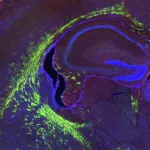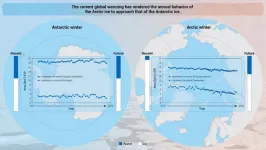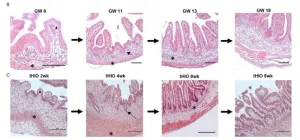(Press-News.org) Genes make up only a small fraction of the human genome. Between them are wide sequences of DNA that direct cells when, where, and how much each gene should be used. These biological instruction manuals are known as regulatory motifs. If that sounds complex, well, it is.
The instructions for gene regulation are written in a complicated code, and scientists have turned to artificial intelligence to crack it. To learn the rules of DNA regulation, they’re using deep neural networks (DNNs), which excel at finding patterns in large datasets. DNNs are at the core of popular AI tools like ChatGPT. Thanks to a new tool developed by Cold Spring Harbor Laboratory Assistant Professor Peter Koo, genome-analyzing DNNs can now be trained with far more data than can be obtained through experiments alone.
“With DNNs, the mantra is the more data, the better," Koo says. “We really need these models to see a diversity of genomes so they can learn robust motif signals. But in some situations, the biology itself is the limiting factor, because we can’t generate more data than exists inside the cell.”
If an AI learns from too few examples, it may misinterpret how a regulatory motif impacts gene function. The problem is that some motifs are uncommon. Very few examples are found in nature.
To overcome this limitation, Koo and his colleagues developed EvoAug—a new method of augmenting the data used to train DNNs. EvoAug was inspired by a dataset hiding in plain sight—evolution. The process begins by generating artificial DNA sequences that nearly match real sequences found in cells. The sequences are tweaked in the same way genetic mutations have naturally altered the genome during evolution.
Next, the models are trained to recognize regulatory motifs using the new sequences, with one key assumption. It’s assumed the vast majority of tweaks will not disrupt the sequences’ function. Koo compares augmenting the data in this way to training image-recognition software with mirror images of the same cat. The computer learns that a backward cat pic is still a cat pic.
The reality, Koo says, is that some DNA changes do disrupt function. So, EvoAug includes a second training step using only real biological data. This guides the model “back to the biological reality of the dataset,” Koo explains.
Koo’s team found that models trained with EvoAug perform better than those trained on biological data alone. As a result, scientists could soon get a better read of the regulatory DNA that write the rules of life itself. Ultimately, this could someday provide a whole new understanding of human health.
END
AI training: A backward cat pic is still a cat pic
2023-05-05
ELSE PRESS RELEASES FROM THIS DATE:
Archaeologists map hidden NT landscape where first Australians lived more than 60,000 years ago
2023-05-05
Scientists at Flinders University have used sub-surface imaging and aerial surveys to see through floodplains in the Red Lily Lagoon area of West Arnhem Land in Northern Australia.
These ground-breaking methods showed how this important landscape in the Northern Territory was altered as sea levels rose about 8,000 years ago.
Their discovery shows that the ocean had reached this, now inland region, which has important implications for understanding the archaeological record of Madjedbebe—the oldest archaeological site in Australia.
The findings also provide a new way to understand ...
A special omega-3 fatty acid lipid will change how we look at the developing and ageing brain, Duke-NUS researchers find
2023-05-05
SINGAPORE, 5 May 2023 – Scientists from Singapore have demonstrated the critical role played by a special transporter protein in regulating the brain cells that ensure nerves are protected by coverings called myelin sheaths. The findings, reported by researchers at Duke-NUS Medical School and the National University of Singapore in the Journal of Clinical Investigation, could help to reduce the damaging impacts of ageing on the brain.
An insulating membrane encasing nerves, myelin sheaths facilitate the quick and effective conduction of electrical signals throughout the body’s nervous system. When the myelin sheath gets damaged, nerves may lose their ability ...
Similar but different: Antarctic and Arctic sea ice and their responses to climate change
2023-05-05
Results were published on March 29 in Ocean-Land-Atmosphere Research. Researchers used data from previous publications aiming to answer the question of why the Arctic sea ice is responding much more quickly and obviously than the Antarctic sea ice, which has stayed relatively stable according to the long-term studies monitoring the Antarctic region’s sea ice patterns.
“The differences in responses are explained in terms of geographic, climatic and
meteorological differences between the two regions. Arctic sea ice is located in the
polar area and encircled by land, while sea ice in the Antarctic ...
Study identifies messages about vaccinating children against COVID-19 that resonate best with vaccine-hesitant parents
2023-05-05
A study from Ann & Robert H. Lurie Children’s Hospital of Chicago found that parents with children who were not yet vaccinated against COVID-19 were most likely to vaccinate their child after reading the following hypothetical scenario:
You hear from other parents you trust that they have vaccinated their children against COVID-19. Some of them say that they weren’t sure at first about whether the vaccine is safe for kids. But they ended up deciding that it was the best way to fight COVID-19, and the vaccination went fine. ...
Organoids validated as tool for studying fetal intestine development
2023-05-04
Developmental biologists have learned a great deal about how the human digestive tract functions through many years of studies involving fish, frogs, and rodents along with detailed explorations of individual human cells. But nothing quite matches the learning that could be achieved from studying actual human organ systems as they form.
Yet for obvious reasons, running experiments on growing human fetuses is both unethical and illegal.
Now a study led by researchers at Cincinnati Children’s, published online April 18, 2023, in the journal Development, reports that lab-grown tissues called organoids accurately mimic key development stages of the human intestine.
“Achieving ...
New free-to-read collection shares research on the Southwest Asian and North African region
2023-05-04
Sage has launched a free-to-read collection of research and other resources that explore the Southwest Asian and North African (SWANA) region. Categories in the collection include:
gender role and oppression
governments, laws, and policies
information and media
mental health, healthcare, and medicine
protests, conflicts, and war
refugees, displaced, and stateless people
Readers can access the Southwest Asia and North Africa microsite free for a limited time. END ...
Cleveland Clinic Rare Disease Center recognized as a National Center of Excellence by National Organization for Rare Disorders
2023-05-04
May 4, 2023, Cleveland: Cleveland Clinic has been designated a Rare Disease Center of Excellence by the National Organization for Rare Disorders (NORD). The new Cleveland Clinic Center for Rare Diseases is one of 40 U.S. academic medical centers selected to join the first-of-it-kind national network dedicated to diagnosing, treating and researching all rare diseases.
The NORD Rare Disease Centers of Excellence program provides a much-needed national infrastructure to help accelerate advancements for rare diseases. The network of medical institutions, led by NORD, is designed to improve rare disease patient care by connecting patients to appropriate specialists regardless of disease ...
Adding epigenetic drug to standard chemotherapy was effective in pilot study for T-cell lymphoma
2023-05-04
Nearly 90 percent of patients with an aggressive subtype of non-Hodgkin lymphoma had their cancer go into remission in a small phase 2 clinical trial testing a treatment aimed at making chemotherapy more effective, according to Weill Cornell Medicine and NewYork-Presbyterian investigators.
The clinical trial, whose results were published May 4 in Blood, included 17 patients with a type of blood cancer called peripheral T-cell lymphoma with T-follicular helper phenotype (PTCL-TFH), also known as angioimmunoblastic T-cell lymphoma. Fifteen of them (88.2 percent) had complete ...
What really killed COVID-19 patients: it wasn’t a cytokine storm
2023-05-04
· No evidence of cytokine storm in critically ill patients with COVID-19
· Nearly half of patients with COVID-19 develop a secondary bacterial pneumonia
· Crucial to find and aggressively treat secondary bacterial pneumonia in ICU patients
CHICAGO --- Secondary bacterial infection of the lung (pneumonia) was extremely common in patients with COVID-19, affecting almost half the patients who required support from mechanical ventilation. By applying machine learning to medical record data, scientists at Northwestern University Feinberg School of Medicine found that secondary bacterial pneumonia that does not resolve was a key ...
Many older adults take multiple medications; an updated AGS Beers Criteria® will help ensure they are appropriate
2023-05-04
New York (May 4, 2023) — Today, the American Geriatrics Society (AGS) released the 2023 update to the AGS Beers Criteria® for Potentially Inappropriate Medication Use in Older Adults (DOI: 10.1111/jgs.18372). The AGS Beers Criteria® serves as a comprehensive list of medications that older people should potentially avoid or consider using with caution because they often present unnecessary risks for this population. Given that, according to the National Center for Health Statistics, United States (NCHSUS), more than 88% of older people use at least one prescription and more than 66% use ...



